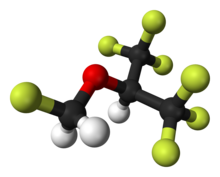Sevoflurane
 |
|
 |
|
| Clinical data | |
|---|---|
| Trade names | Sojourn, Ultane, Sevorane |
| AHFS/Drugs.com | Consumer Drug Information |
| Routes of administration |
inhaled |
| ATC code | |
| Legal status | |
| Legal status | |
| Identifiers | |
|
|
| CAS Number | |
| PubChem CID | |
| IUPHAR/BPS | |
| DrugBank | |
| ChemSpider | |
| UNII | |
| KEGG | |
| ChEBI | |
| ChEMBL | |
| ECHA InfoCard | 100.171.146 |
| Chemical and physical data | |
| Formula | C4H3F7O |
| Molar mass | 200.055 g/mol |
| 3D model (Jmol) | |
| Boiling point | 58.5 °C (137.3 °F) |
|
|
|
|
|
|
|
Sevoflurane (1,1,1,3,3,3-hexafluoro-2-(fluoromethoxy)propane; synonym, fluoromethyl hexafluoroisopropyl ether), is a sweet-smelling, nonflammable, highly fluorinated methyl isopropyl ether used as an inhalational anaesthetic for induction and maintenance of general anesthesia. After desflurane, it is the volatile anesthetic with the fastest onset and offset.
It is one of the most commonly used volatile anesthetic agents, particularly for outpatient anesthesia, across all ages, as well as in veterinary medicine. Together with desflurane, sevoflurane is replacing isoflurane and halothane in modern anesthesiology. It is often administered in a mixture of nitrous oxide and oxygen.
Sevoflurane "has an excellent safety record", but is under review for potential neurotoxicity, especially relevant to administration in infants and children, and rare reports similar to halothane hepatotoxicity. Sevoflurane is the preferred agent for mask induction due to its lesser irritation to mucous membranes.
Sevoflurane was discovered by Ross Terrell and independently by Bernard M Regan. A detailed report of its development and properties appeared in 1975 in a paper authored by Richard Wallin, Bernard Regan, Martha Napoli and Ivan Stern. It was introduced into clinical practice initially in Japan in 1990. The rights for sevoflurane worldwide were held by AbbVie. It is now available as a generic drug.
Sevoflurane is an inhaled anaesthetic that is often used to put children asleep for surgery. During the process of waking up from the medication, it has been known to cause agitation and delirium. It is not clear if this can be prevented.
...
Wikipedia
